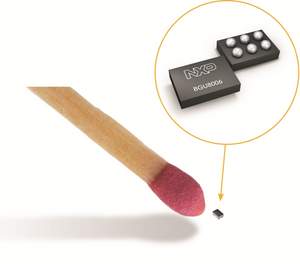By Kalwinder KaurJun 22 2012
NXP Semiconductors (NXP), a provider of high performance mixed signal and standard product solutions, has introduced a new low-noise amplifier (LNA), the BGU8006, for enhancing GPS reception in very small portable devices. Claimed to be the tiniest available wafer-level chip-scale package (WLCSP) GPS LNA, it has a footprint of 0.65x0.44 x 0.2 mm.
 NXP's new BGU8006 low-noise amplifier is the tiniest GPS LNA on the market today, with a footprint of just 0.65 x 0.44 x 0.2 mm
NXP's new BGU8006 low-noise amplifier is the tiniest GPS LNA on the market today, with a footprint of just 0.65 x 0.44 x 0.2 mm
When compared to other similar solutions, the BGU8006 helps save 38% space on PCBs. The LNA dynamically suppresses WLAN transmit signals and strong cellular signals, enabling a strong reception for GPS signals that may be weak. The BGU8006 has a low noise figure of 0.60 dB. Only two external components – a decoupling capacitor and a matching inductor are required for the LNA.
When a network faces poor reception, devices such as smartphones, personal navigation devices and tablets have to wait till the GPS searches for and acquires a new satellite signal. The new LNA has the ability to maintain the reception of a GPS signal for a long period.
The LNA’s WLCSP technology minimizes parasitic inductance. The LNA does not have any interposer connections, bond wires or leads, which help optimize the thermal characteristics, cost and package size.
NXP is also offering the BGU8007 LNA in a 6-pin leadless SOT886 package of size 1.45x1.0x0.5 mm. The BGU800x series LNAs can be used for many GPS-enabled applications such as smartphones, digital video cameras, digital still cameras, personal navigation devices, and tablets.
The company will be showcasing the BGU800x series LNA products at the IEEE MTT-S International Microwave Symposium (IMS2012).
Disclaimer: The views expressed here are those of the author expressed in their private capacity and do not necessarily represent the views of AZoM.com Limited T/A AZoNetwork the owner and operator of this website. This disclaimer forms part of the Terms and conditions of use of this website.